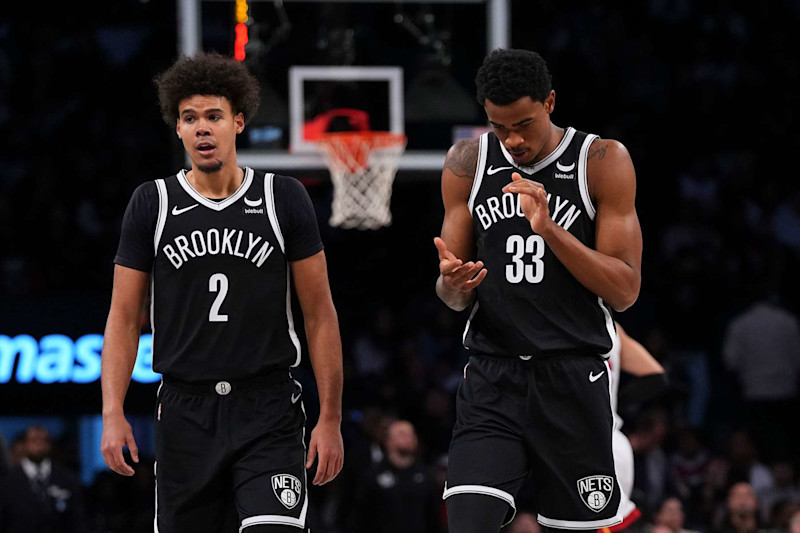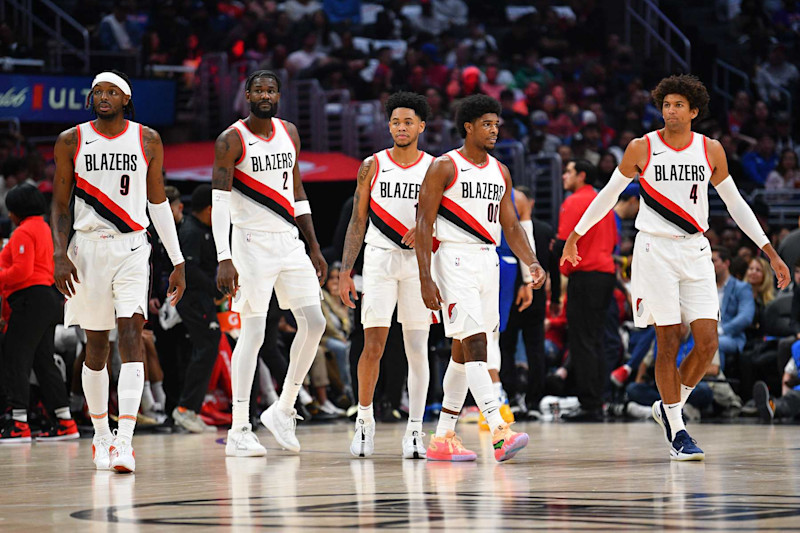The Cooper Flagg sweepstakes take place in 2025, and it’s not too early for NBA lottery teams to dream.
Nobody will have to worry about fit with a player who possesses Flagg’s size, versatility and lack of a flaw that needs masking.
Winning next May’s lottery could instantly change a franchise’s trajectory and force the front office to make moves to accommodate its new franchise player.
We picture Flagg joining eight different teams that recently chose to reset and build around young players.
Brooklyn Nets

Mitchell Leff/Getty Images
Timing had something to do with the Brooklyn Nets’ decision to trade Mikal Bridges and reset. For a team that didn’t have a realistic short-term pathway to contention, the upcoming season was considered an acceptable one to punt with Flagg finally eligible for the draft.
While there are negatives that come with joining a team starting from scratch, Flagg would receive a beneficial, heavier dose of creation opportunities in Brooklyn.
The athleticism and instincts for transition offense, play-finishing, passing and defensive playmaking will translate first at Duke and then the pro level, but an improving handle, one-on-one skills and shot-making game are what’s driven the recent hype to new/rare levels. And with Brooklyn, Flagg would be walking into a high-usage role and get the freedom to experiment with self-creation.
That may also make it difficult for him to score with the type of efficiency (as a rookie) he’d reach on a more established roster. Still, Cam Johnson, Cam Thomas and Dennis Schroder would be able to surround him with respectable shooting, while Thomas and Schroder could also generate enough gravity to regularly create quality off-ball scoring chances for Flagg.
For the Nets, they’d have an instant new identity built around the defensive pairing of Flagg and Claxton. Together, their court coverage, switchability and rim protection would cause instant problems and give Brooklyn an exciting defensive ceiling long term.
Charlotte Hornets

Jacob Kupferman/Getty Images
On paper, the Charlotte Hornets look like an interesting fit for Flagg. The team could use another frontcourt weapon, and Flagg would get to play with an elite passer in LaMelo Ball and surrounding shot-makers in Brandon Miller and Miles Bridges.
Injuries to Ball and Mark Williams have delayed the team’s progress and prevented us from seeing the lineup’s potential. But at full strength with Flagg at the 4, the Hornets would have a talented and balanced roster.
Flagg would likely cut into Bridges’ on-ball reps, but Bridges was a fine spot-up shooter last season. Still, the fact that Flagg possesses special built-in tools, athleticism and motor for off-ball scoring would be very useful in an offense that will run through Ball and Miller in the short term.
Between Flagg and Williams, the Hornets would also have two easy-basket targets and defensive disruptors to pair with Ball, Miller and Bridges.
Detroit Pistons

Brian Sevald/NBAE via Getty Images
With Trajan Langdon and Dennis Lindsey now in charge of the Detroit Pistons, this will be an evaluation year for many of the draft picks made by former general manager Troy Weaver. We don’t know who Ausar Thompson, Ron Holland, Jaden Ivey and Jalen Duren will be this time next year, and roster changes could occur, clouding projections for how Flagg would look in the lineup.
It’s still safe to assume the Pistons offense will continue running through Cade Cunningham, and the rotation will depend on Thompson and Holland for athletic and defensive plays from the wings.
Flagg would inevitably replace placeholder Tobias Harris at the 4 and give Cunningham an elite transition weapon, exciting play-finisher and initially a secondary scorer. Adding Flagg may sway Detroit to keep a shooter like Tim Hardaway Jr. or pivot from Duren to a stretch 5.
Flagg has improved his range, but it won’t be a strength early, and high-priority youngsters Thompson, Holland and Ivey have questions to answer about their shooting development.
Fit aside, Flagg is seen as one of the decade’s surest All-Star bets, and since Detroit selected Cunningham, bad luck during lottery nights has hurt Detroit’s chances of adding an All-Star in the draft. A Cunningham-Flagg nucleus would provide a wide-ranging mix of positional size, athleticism, skill, IQ and defense, but that one-two punch would also require specific role players.
Portland Trail Blazers

Brian Rothmuller/Icon Sportswire via Getty Images
Adding Flagg would likely force the Portland Trail Blazers to make a trade, if they haven’t already by the 2025 draft.
With a new franchise player and Jerami Grant and Deandre Ayton on separate timelines as recent top-10 picks Scoot Henderson, Shaedon Sharpe and Donovan Clingan, it would be time to make some moves.
The future Blazers would show Clingan protecting the rim and Flagg flying around defensively.
Offensively, Flagg would start off in more of a play-finishing and spot-up role with Henderson and Anfernee Simons (deal expires in 2027) taking most of the ball-handling and creation reps. Still, if Grant leaves, Flagg would receive plenty of usage. And depending on how much Henderson improves his shooting, decision-making and finishing, Flagg could quickly steal touches and play more of a point-forward role early on.
San Antonio Spurs

Photos by Jesse D. Garrabrant/NBAE via Getty Images
Flagg joining Victor Wembanyama could change the landscape of the Western Conference.
The roster would still require more work, but five years from now, there may not be a more dominant pairing in the league. Both Flagg and Wembanyama possess enough inside-out versatility to work well together offensively, while their physical tools, athleticism and instincts would give San Antonio one of the NBA’s highest defensive ceilings.
Their competitiveness and professionalism from early ages only make it scarier to picture them leading a team together.
The Spurs did rank No. 26 in offense last year, and while Chris Paul will help in that department in 2024-25, and Stephon Castle is a promising wing with playmaking skills, San Antonio will eventually have to find another ball-handler to build with.
Regardless, Flagg would be used heavily early by the Spurs, both on and off the ball.
As it stands, he could play alongside shooting threats in Devin Vassell, Harrison Barnes and Wembanyama. But ideally, the Spurs would want to give Flagg another playmaker and a higher-gravity creator in the backcourt.
Toronto Raptors

Adam Pantozzi/NBAE via Getty Images
It would be difficult to imagine getting more versatility from the forward spots if the Toronto Raptors can pair Scottie Barnes with Flagg.
There is some repetition in their archetypes and skill sets, but it shouldn’t prevent either from properly developing. The Raptors could unleash two big wings or combos that can handle and pass and make unteachable defensive plays
Adding surrounding shooters would continue to be a priority, though Immanuel Quickley has always been dangerous, Gradey Dick will be soon (based on a large sample size of scouting) and RJ Barrett shot well after being traded to the Raptors.
Coach Darko Rajaković may also want to experiment with Flagg and Barnes at the 4 and 5, considering their abilities to play big defensively, and the room it opens for the team to use more shooters at positions 1-3.
Otherwise, the Raptors could go big with Flagg, Barnes and Jakob Poeltl.
Utah Jazz

Chris Gardner/Getty Images
The Utah Jazz are trying to escape the rebuilding stage, though their three key 2024 draft picks won’t move the needle significantly as rookies. This team could once again be in the lottery and in play for Flagg, whose athleticism, passing and defense would complement Lauri Markkanen’s perimeter scoring and shooting.
We’re still waiting to see what happens with Taylor Hendricks’ development, but even a promising sophomore jump would push him to the bench if Utah won the 2025 lottery.
Adding Flagg would also raise the probability of John Collins’ time ending in Utah.
If Cody Williams makes himself a must-play rotation player by 2025-26, the Jazz could use Flagg as a small-ball 5.
It’s difficult to say whether the Jazz would be a good spot for Flagg until we know more about their guard situation. Collin Sexton and Jordan Clarkson will be entering the final year on their deals in 2025-26, and Keyonte George has an important season ahead to make a case for Utah’s lead guard of the future who can balance scoring with good decision-making and passing.
Washington Wizards

Monica Schipper/Getty Images
Picturing Flagg on the Washington Wizards means visualizing him playing alongside last June’s No. 2 pick, Alex Sarr.
The obvious appeal to pairing them stems from their ability to raise the team’s defensive ceiling. It would seem ideal to have a 4 and 5 that each provide switchability, recovery speed and the tools/athletic ability to erase shots.
Offensively, we still don’t know what the Wizards will have or look like by this time next year. They’ve taken five players in the first round over the past three drafts. Sarr lacks polish and remains far away, as evidenced by summer league. Bub Carrington just turned 19, Bilal Coulibaly just turned 20 and Kyshawn George’s game has gradually evolved.
The biggest question asks how Washington would deal with the overlap/logjam between Flagg, Kyle Kuzma, Coulibaly and Jordan Poole. But Poole’s and Kuzma’s contracts are up in 2027. Long term, Flagg will likely play between Coulibaly and Sarr, with the hope that Coulibaly and Sarr both continue to make strides with their shooting range.
Washington is banking on Carrington to run away with the starting point guard job. Regardless, based on the current roster, Flagg should have plenty of opportunities to experiment with his creation, ball-screen play and one-on-one game. But he’d still benefit from Carrington developing into a trusted playmaker or the Wizards finding a way to trade for or sign a veteran ball-handler.
Leave a Reply